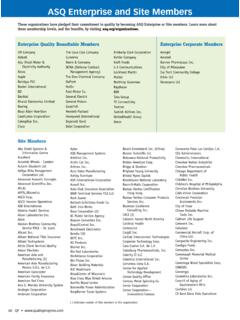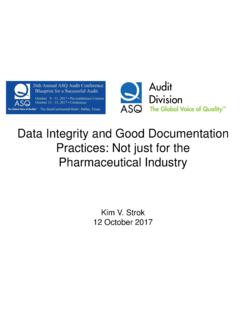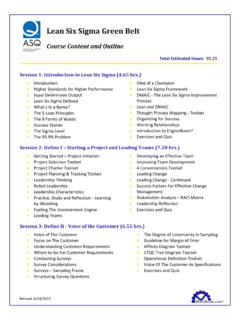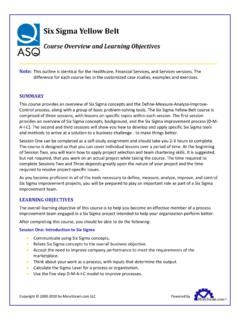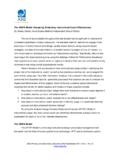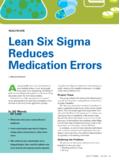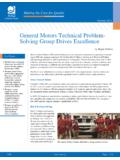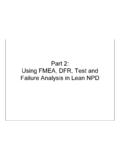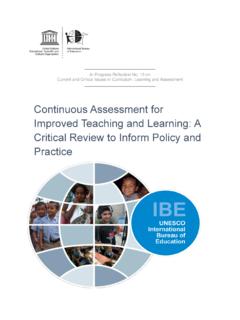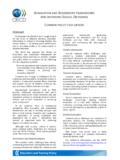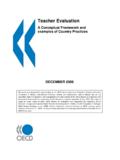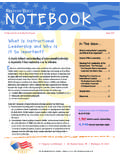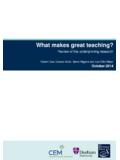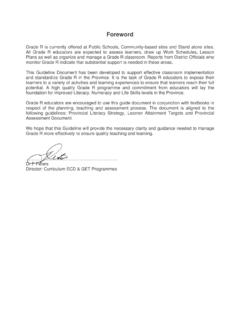Transcription of Improving business Case Study: Application of …
1 31 Quality Approaches in higher education Vol. 6, No. study : Application of DMAIC to academic assessment in higher EducationAndrew S. Bargerstock and Sylvia R. RichardsAbstractAt a small university in the Midwestern part of the United States where Lean Six Sigma is a lively imperative, a newly trained kaizen team applied the Deming five-stage Define-Measure-Analyze-Improve-Control (DMAIC) methodology to streamline and improve efficiencies for an academic assessment process. In this case of the close-the-loop (CTL) report, the targeted process was a procedure for assessing effective delivery of course out-comes and for planning instructional improvements for all courses taught in the College of business at Maharishi University of Management in Fairfield, IA.
2 Through a structured lean improvement event ( , kaizen), a cross-functional team utilized its recent training in Lean Six Sigma to streamline the efficiency of the CTL process and boost faculty compli-ance. The enhanced CTL process reduced cycle time by two-thirds, removed frustrating non-value-added activity steps, discovered additional customer value, and boosted compli-ance rates significantly. Keywords Continuous Improvement, Lean/Six Sigma/DMAIC, Quality Assurance, Process Management, Best PracticesIntroductionIn the decades since W. Edwards Deming (1986) began consulting with Japanese industries in the 1950s on how to improve quality controls for production systems, the world has witnessed an evolution of organizational developmental philosophies that have moved sequentially from quality control to total quality management to lean management (lean).
3 Although the roots of lean spring from Japanese manufacturing, Womack, Jones, and Roos (1990) revealed a more generic set of elements, rules, and tools that can be applied to any organization including manufacturing, merchandising, service-oriented, non-profit, governmental, and educational the late 1980s, Xerox Corporation adopted Deming s Define, Measure, Analyze, Improve, Control (DMAIC) methodology to resolve inefficiencies in its business pro-cesses. Gradually, Xerox also used DMAIC as a tool to improve information f low into, through, and out of its educational clients (Kurt, 2004). George (2003) also demon-strated how continuous process improvement (CPI) methods have been adapted to service ReviewIn higher education , lean methods have been introduced in various forms.
4 CPI initia-tives have been incorporated within the classroom as experiential learning opportunities (Hand, Dolansky, Hanahan, Sundaram, & Tinsley, 2014). Systems thinking has been embraced as a conceptual framework within educational organizations in order to go beyond functional silos to sustain consistent improvement over time (Furst-Bowe, 2011). A business case was made for using Lean Six Sigma to support a systems-thinking and project-based approach for improvement in higher education (Simons, 2013). Emiliani (2015) has focused on implementing lean with instructional methods in a variety of ways. Improving business processes in higher education through Approaches in higher education Vol. 6, No. DMAIC method has been increasingly utilized to solve problems in higher education administration (Ramanan & Ramanakumar, 2014).
5 It has been applied in administrative practices to improve process consistency and to reduce cycle time in salary calculations in higher education institutions (Utecht & Jenicke, 2009). At Central Michigan University, DMAIC was adopted by information systems faculty for the purposes of aca-demic program design and curriculum development (Holmes, Jenicke, & Kumar, 2005). Sarda, Bonde, and Kallurkar (2006) demonstrated the role of DMAIC in a technical institution for continuously Improving student results. However, there is a lack of papers describing how DMAIC is used to streamline academic assessment processes. This arti-cle presents a case study applying the classic five-step DMAIC Lean Six Sigma procedure for Improving business processes.
6 At Maharishi University of Management, the timely and complete delivery of each course s close-the-loop (CTL) report is needed by academic program directors who monitor student course sat-isfaction and faculty plans for Improving their curriculum and classroom 1999 when the higher Learning Commission (HLC) established the academic Quality Improvement Program (AQIP), many institutions in higher education have been dis-covering ways to improve their quality improvement cultures ( higher Learning Commission, 2015). Maharishi University of Management is an accredited university located in Fairfield, IA, offering degrees with , , and programs in vari-ous academic disciplines. Overall, in spring 2015, enrollment for resident and online degree programs exceeded 1,400 students.
7 In 2012, executive leadership established a core group for applying tools of lean management to enhance communication with students, alumni, and faculty, while producing improve-ments to selected business processes. As enthusiasm and interest grew from these pilot projects, in 2013 the university decided to engage an outside consulting group to provide training in lean facilitation for a combined group of approximately 40 faculty and administrative leaders. After the training, the university s lean steering committee approved a series of kaizen events to validate the training as pilot projects. Although there were some good results, it became apparent that the teams needed some additional techniques in data collection, baselining, and prob-lem analysis.
8 Consequently, in October 2014, two business faculty mem-bers, both certified lean facilitators, agreed to provide the next generation of training to a new set of faculty and administra-tors in conjunction with the executive leaders of the lean steering committee team and leaders. Both facilitators possessed solid credentials. Thomas Palladino had earned a Six Sigma Black Belt and was an experienced human resources executive and trainer with more than 30 years of experience in corporate human resources management. The other certified lean facilitator and chair of the accounting department in the college of business , Andrew Bargerstock, had consulted in numerous lean projects on administrative processes within businesses, federal and state agency organizations, and training was delivered in five, half-day sessions that cov-ered a discrete sequence of topics.
9 Lean history and structure, project selection, team selection, process mapping, baselining and data collection, root-cause analysis, future-state mapping, implement-ing and standardizing changes, and monitoring and the college of business , an MBA program administrator, Sylvia Richards, took the role of lead facilitator for the CTL report project and began building the framework for a kaizen event during the week of training. In the weeks that followed, she led a team toward improvement solutions. This case study follows the five sequential DMAIC stages that were presented in the university s lean management train-ing program. For this kaizen event, the five stages unfolded in this manner: Define Selecting and planning the project.
10 Measure Gathering data on the current level of effectiveness of the process. Analyze Mapping/understanding the process and discovering forms of waste. Improve Utilizing collaborative problem solving to remove non-value-added elements. Control Standardizing, monitoring, and managing process 1, Define: Selecting and Planning the Project. The selection and planning of the project involved identify-ing the CTL project, determining the existence of a business case , and developing the project charter. Identifying the CTL Project. When the MBA program administrator announced she was participating in the CPI train-ing in October 2014 and that she was looking for a project to complete during the training, one of the then business depart-ment co-chairs, Scott Herriott, jumped at the idea of a kaizen event on a critical departmental business process that he felt needed attention.


